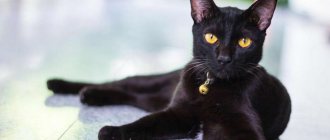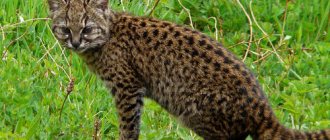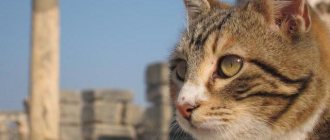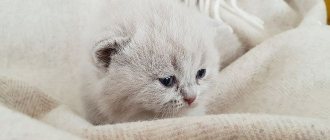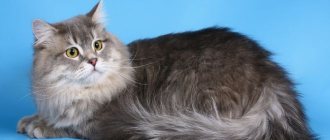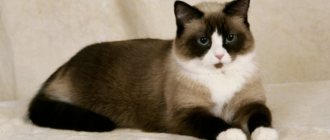The Bombay cat is the blackest black cat in existence; she looks like a mini panther, gracefully moving through a city apartment in search of prey. They say that in the dark it is not visible at all, its color is so dark, and only its eyes glowing in the darkness can reveal the presence of a panther at home. Despite the unusual name that breeder Nikki Horner gave her puma-like hybrid, the Bombay breed has no connection to the city of Bombay in India. A panther-like cat was bred by breeders in the USA by crossing Burmese cats with black American shorthairs and registered the new breed in 1976.
The Bombay cat is the blackest black cat in existence.
The crossing experiment turned out to be very successful: the domestic panther does not have a single light spot on its fur, even its nose and paw pads are deep black, which emphasizes its resemblance to a puma. Bright golden eyes sparkling against a dark background only highlight the night beauty of her coloring. Nikki Horner, an American breeder who dreamed of seeing a black panther in her home, spent more than 18 years making this dream a reality. And finally, the first Bombay in the CIS was brought from the USA to Minsk, to the Bagilis nursery, in 2006.
Brief history of the breed
Work on the creation of Bombay cats began in the 1950s with the light hand of Nicky Horner. To obtain animals that resemble a small panther, the woman crossed an American Shorthair and a representative of the Burmese breed.
The first experiment was not successful - the kittens born were far from the standard. But Horner’s persistence paid off, and in 1970, the Cat Fanciers Association registered a new breed.
6 years later, Bombay received championship status. Then work on improving these animals was continued by other breeders. Today the breed is recognized by all leading felinological organizations, but is classified as rare.
In 2000, fewer than 100 Bombay cats were registered with the CFA.
How and where did the Bombay cat appear?
There is no need to think that little Bagheera’s ancestors conquered Bombay. And she herself has nothing to do with this most beautiful city of India. As strange as it may sound, cats originated in the United States of America, or more precisely in Kentucky.
Breeder Nicky Harter, fascinated by the grace and beauty of the panthers living near Bombay, decided to create a new breed of cats. She wanted her pets to resemble little panthers. The selection took 20 years, but the results did not please Niki. She crossed Burmese animals with American Shorthairs, but their descendants did not gain recognition.
The experiment was continued by people named Zwecker, Sbzanna and Herb. After many attempts, they finally bred a panther cat named Luv It Black, which charmed everyone and won second place at a felinological exhibition in the mid-eighties of the last century.
There are not that many cats in the whole world. At the beginning of the 2000s there were less than a hundred of them. Therefore, Bombays are very valuable and are not so easy to buy.
Breed description, standards, appearance
Bombay cats are graceful short-haired animals with a developed muscular corset, a wise look and predatory movements. Due to certain differences in appearance, there is a conditional division into the British and American lines of the Bombay cat.
A detailed description of the breed is presented in the generally accepted standard.
Dimensions and weight
Representatives of the Bombay cat breed are not large animals. The average weight of an adult male is 5-5.5 kg. The weight of the Bombay cat varies between 3-4 kg.
Anatomical characteristics
The Bombay cat can be easily distinguished from a regular cat by a number of specific characteristics. According to the standard, a typical representative of the breed must meet the following description:
- The head is medium-sized, rounded, with a wide muzzle, powerful jaws and a visualized stop. The Bombay's nose may be slightly flattened. The teeth are white, healthy, and set in a scissor bite.
- The eyes are round and widely set. The American-type Bombay has an iris of amber-golden shades. The British standard allows for the existence of green-eyed individuals.
- The ears are medium in size, set wide apart with rounded tips. Slightly tilted forward.
- The body is elongated, proportionally built, with developed muscles, a broad chest and powerful shoulders.
- The limbs are of medium length, muscular, slender with small rounded paws and strong claws.
- The tail is strong and of medium thickness. Tapers slightly towards the tip.
Color and coat type
The body of the Bombay cat is covered with a short, thin, shiny awn, under which there is no down at all. The wool fits tightly to the animal's body and feels like natural silk.
The breed standard allows only coal-black coloring without spots or medallions. All other colors are prohibited and are a reason to doubt the purity of the cat.
Possible breed defects
Disadvantages of the exterior, in the presence of which the Bombay cat cannot receive a high expert assessment:
- bite defects;
- polydactyly;
- any color other than jet black;
- spots and medallions on wool;
- curled tail;
- sharp bend of the nose.
Breed characteristics of the Bombay cat
- Head. Panthers have a round, neat, medium-sized head with a wide muzzle. Viewed from the front - without sharp bends or creases. When viewed in profile, the presence of a pronounced moderate sling is characteristic, which should not turn into a kink (flaw). The tip of the nose is slightly rounded down. The cat has a strong but not wide chin, rounded chin pads, a correct bite and a well-developed lower jaw. And also noticeable but taut cheeks and high cheekbones. A very smooth transition from the chin to the cheekbones. The breed has a narrow, visually even bridge of the nose with a barely perceptible small dimple, a wide and high sloping forehead, smoothly rounding and turning into the back of the head. Neck. Medium length and width, flexible and graceful.
- The ears are medium in size, wide and high set, alert. Rounded at the tips, without pubescence, with a slight forward slope.
- Eyes. Large in size, round in shape, very expressive, set wide apart. They are located widely on the muzzle. Honey-amber is considered the most successful color, but it is quite rare, so golden eyes are allowed.
- At birth, kittens have blue eyes , which after they reach the age of six months turns into gray, and only by the age of one year does a rich orange color appear. But animals with this eye color, especially cats, from about five years old, may disappoint you - the eye color may suddenly change to greenish.
- Body. Medium, slightly elongated. With well-developed muscles and amazing flexibility. A petite or thin body type is not acceptable. The breed is characterized by a proportionally wide back, level and sloping. The shoulder and pelvic girdles are almost the same width.
- Paws. Not long, with a characteristic slenderness, proportional. The ends of the legs are rounded with tucked toes. (there should be 5 toes on the front legs and 4 on the hind legs, any other number is unacceptable).
- Tail. Should be in proportion to the body, dense, strong, straight, with characteristic flexibility and mobility, slightly tapering towards the end. If the tail is bent or disproportionate to the body, the animal is disqualified.
Bombays are medium-sized cats - from 25 to 30 cm at the withers. Body weight of an adult pet: females - 3-4 kg, males 4-6 kg.
Characteristics of coat and color. The coat should be short, close-fitting and shiny, as if covered with varnish. Only black coat color is allowed. Young kittens may have small white spots on their fur and slight fluffiness, but by the age of one year the fur coat changes to that of an adult. Everything should be black - from the crumbs on the fingers to the nose.
Character and temperament
Bombay cats inherited from their ancestors not only external characteristics, but also good character. From American Shorthairs they inherited a balanced and reserved disposition. From the Burmese, Bombay cats inherited sociability and devotion to people.
On a note. Bombay cats do not single out one owner for themselves. They treat all family members with equal tenderness and get bored when apart.
The Bombay cat is endowed with a non-conflict character. She gets along with children without problems and rarely shows her claws. In an uncomfortable situation, a cat of this breed will prefer to hide in a safe place.
Friendliness is the main characteristic of Bombay. A cat of this breed treats other pets well and gets along calmly under the same roof with decorative birds and rodents.
Hand Panther: Features of the Bombay Cat Breed
Charming beauty, mystical grace and black grace - all this is about the Bombay breed. This adorable feline resembles a miniature panther, which gets along well at home.
Origin story
Unlike most other species, Bombays were bred purposefully. This is solely the result of selection work.
The first kittens of the new breed appeared in the mid-20th century in America. At this time, breeder Nicky Horner decided to breed a domestic copy of the black panther. The Burmese and American Shorthair became the “grandmothers” and “grandfathers” of the charming animals.
Selection work has been carried out for several decades. The breed was not recognized by felinological organizations for a long time. Until in 1985, the representative won second place at an international exhibition. From then on, Bombays became popular and began to win the hearts of people with their beauty and wonderful character.
No one knows why the breed was given such a name. The city of the same name in India has nothing to do with black graceful creatures.
Bombay cat: features of the breed
An elongated, strong body, wide chest and well-developed muscles allow the charming Bombay cat breed to show its grace and strength.
This animal is generally distinguished by its special proportionality. He has a medium head, wide and fairly high ears. They give him a wary look. The middle tail is almost without tapering towards the end. The paws are also medium in size.
A feature of the breed is the different number of toes on its paws. There are 5 of them on the front limbs, but the hind limbs have only 4 fingers.
The eyes are also unique: babies are surprised by the world with their blue round eyes. After six months, their shade changes to gray. And by the age of one year, representatives of the Bombay breed acquire the main color. It can be golden, amber-honey or even copper.
The fur is particularly smooth and so shiny that it gives the impression of a carefully polished surface. Short pile will not cause any special problems when caring for your pet. The color can only be black, and all over the body. Deviation is allowed only in infancy. When kittens can sport small light spots.
Character
The charming cat has a calm, balanced character. Although he can happily play, run around and climb heights even at an advanced age.
The Bombay treats all family members well, but special attention will still be given to the chosen “Chief Owner”. Purring and gentle rubbing are provided to such a person almost around the clock. Moreover, this will not necessarily be the head of the family.
They will be happy to meet you at the door after work and gently purr a song. Representatives of this species do not really like to talk, but if they are in such a mood, then this can last a long time.
They love to sit on their laps, enjoying the warmth of their loved one.
Bombay cats are good with children. Even if the kids unknowingly cause pain to the animal, the pet will not show aggression, but will try to hide in a safe place, from where it can watch what is happening with interest.
Curiosity will not leave them indifferent to the arrival of guests of any kind. Bombay cats love the company of people and actively participate in all events of home life. Because of their habit of following a person on a person's heels, cats are often called “Velcro” or “attachers”.
Loneliness will not harm your pet's psyche; he will always find entertainment - it is better to provide him with suitable toys - or he will simply sleep.
Cats love to watch street life, but taking them out for walks is not recommended. They will, of course, endure the change of scenery, but they won’t get much pleasure from it.
Health
Cats are distinguished by good health and live up to 15-18 years. Among the diseases, they can be affected by cardiomyopathy, gum problems, runny nose or skull deformation. In the second case, kittens almost never survive.
Tearing may occur, but timely rinsing of the eyes will solve this problem.
Size and weight
At the withers, Bombays reach 25-30 centimeters. Adult cats weigh about 4-6 kilograms, their graceful friends will be a little more elegant and, when weighed, will show a result of 3-5 kilograms.
Nutrition and care
Bombays love to eat, so owners should not hope that their black miracle will move away from the bowl as soon as its hunger is satisfied. Rather, she will eat everything that is put in front of her and ask for more. However, pets are prone to quickly gaining excess weight, so touching eyes should not make you want to feed him again.
They are happy to eat ready-made food or natural food: lean meat, chicken or turkey, fermented milk products, eggs, cereals.
Caring for the breed is not difficult. The fur needs to be brushed once a week. After finishing brushing, you can “polish” your pet’s back and sides with a suede cloth.
To maintain physical fitness and maintain health, cats of this breed need active games. Ordinary toys will help with this: mice or balls, as well as all kinds of play complexes with labyrinths and steps.
You can buy a special bed for sleeping, but a Bombay won't mind the master's bed.
Price
Exhibition copies are sold at prices starting from 50,000 rubles.
Bombay cats are quite rare, so the price reaches 30,000 rubles, although you can buy a baby for half the price.
How to choose the right kitten
In order not to fall into the trap of scammers and become the owner of a mongrel animal, it is better to look for a Bombay in specialized nurseries or from trusted breeders. It is more advisable to choose a kitten in person, rather than from a photo or video. This way, it will be possible not only to personally verify the availability of documents confirming the origin of the babies, but also to evaluate the conditions of their detention.
On a note. As a child, the Bombay kitten has quite fluffy fur, the color of which does not always correspond to the standard. The baby may have gray hair and white spots.
A healthy Bombay kitten should have clear eyes, a soft belly, evenly growing hair without bald spots, smooth skin without rashes or scratching. He should not have a foul odor from his mouth or dirt in his ears or under his tail.
Kitten care
Until the age of three months, Bombay kittens grow up next to their mother and by the time they move to a new home they become completely independent. Since competent breeders teach babies to use the tray and scratching post in advance, the owners can only show the pets where the bowls and litter box are, and also give them a little time to get used to the changed conditions.
To protect the little Bombay from accidents, wires, flowerpots with indoor plants, household chemicals, and fragile and small things are hidden from him. Also, for safety reasons, special nets are placed on the windows, and the oven and washing machine doors are kept closed.
To prevent the Bombay kitten from experiencing stress from a sudden change in diet, at first it is fed what the breeder advised. The meal schedule depends on the age of the animal:
- up to 2 months – 5-6 times a day;
- 2-5 months – 4 times a day;
- 5-12 months – 3 times a day.
From the age of one year, the Bombay black cat is transferred to two feedings a day.
Olga Volkova about panteretta
At one time, Carlson, who lives on the roof, only needed to make a hole in the sheet, and he immediately became a ghost with a motor, wild but cute. Many of us would like to have something as wild, but cute. “Wild” - because, frankly speaking, civilization has already had enough of it. And “but nice” - because we, all because of this excessively tired civilization, are mostly timid, even cowardly people, we cannot handle real savagery. In response to our thirst to touch the wild without getting too scratched, new cat breeds began to appear one after another, quite successfully imitating the appearance of predators, but with a relatively harmless character.
So, the toyger looks like a small tiger, the Bengal cat looks like a leopard, and its silver version looks like a snow leopard, the savannah and Serengeti look like a serval, the ocicat copies an ocelot, the pixie bob is a real small lynx, the safari is the spitting image of Geoffroy’s cat, the chausie is exactly just like a jungle cat. Breeders work tirelessly, I don’t even know why, every now and then delighting the world with a new unprecedented cat breed. And at times taking great risks: yes, some of the above-mentioned breeds were prepared exclusively by the efforts of various but ordinary domestic cats, but for the appearance of others it took the participation of real servals, jungle cats, ocelots and leopard cats, that is, one hundred percent and sometimes not very friendly predators. It’s a little scary to approach such people, but this won’t stop a true creator of new cats.
Some of these wild but cute breeds are already officially recognized, others are not yet, and others are under development and considered experimental. These include, in particular, the pantheretta - a cat designed to get as close as possible to the panther (and without the assistance of real panthers). In fact, some domestic and slightly panther-shaped animals already exist - these are black bombays. But Bombay cats are quite small, about five kilograms, and their contours are not quite what they need. Anyone who dreams of a personal panther would, of course, want someone more predatory. And bigger. At least twice.
But first, let's agree on who exactly we will consider a panther. After all, for us, the panther is Bagheera from Mowgli, all so black and beautiful. Here I am forced to plunge a knife into the heart of all Bagheera fans: there is no such animal as a black panther. Bagheera was a black leopard. And panthers are just one of the genera of the cat family, which includes tigers, lions, leopards and jaguars, and not only black ones. However, the soul does not accept this scientific fact, so I suggest that we continue to ignore it. Let zoologists say what they want, we will still call the one we consider necessary a panther, that is, the black leopard Bagheera. And the pantherette was tailored specifically for her.
The history of the pantherette began several years ago in America, when in the local nursery of Bengal cats - which are most often golden speckled, like a leopard, or silver, like a snow leopard-irbis - a black kitten, the so-called melanist, was suddenly born. This actually happens, but for some reason, just at that time, everyone just gasped - a panther, and that’s all! However, the breeders decided that the panther was a panther, but not quite. And it needs to be absolutely.
It must be said that with panteretta it turned out approximately the same as with the Lomonosov-Lavoisier law, when one law almost simultaneously came to the minds of different people (although now they say that everything was wrong and Lomonosov had nothing to do with it at all). So it is here: the idea of a panther-type cat dawned on our Russian breeders of the same Bengals, so work on the pantherette slowly began on two continents at once. And apparently, the recipe for preparing this cat was more or less similar: the base is a black Bengal, to which, for size and nose, is added a Maine Coon, also, most likely, black. And for the result to be even blacker, a Bombay cat must also take part in the process.
Of all the ancestors of the pantherette, the only one that arose on its own was the Maine Coon - an American aboriginal cat, a 10-15 kg giant that spontaneously arose somewhere in the bushes of Maine. But Bengal cats (also rather large, about 10 kilograms) were bred artificially; their ancestors include both ordinary cats and wild cats, Asian leopards. Bombay cats were also artificially bred - not in India at all, but in the same tireless America, they were prepared with the help of an American shorthair cat and a Burmese cat. In a word, the pantherette has so many ancestors that you can’t remember them all. Moreover, perhaps there are some additional secret ingredients such as ocicat, pixie bob and probably someone else.
But at the heart of it all is a Bengal cat of an atypical black color. Which some people sometimes try to pass off as a ready-made panteretta and sell it to those who are thirsty for many, from two to five or more, thousands of dollars, because a real panteretta costs exactly that much. However, to have the right to be called a pantherette, it is not enough to just be big and black. This experimental breed already has its own standard, which, among other things, presupposes an increased nose and a certain squareness of face - remember what the cartoon Bagheera looked like with its unforgettable profile taken as a model. Her ears should be small and not quite sharp, her tail should be lowered predatorily, thick and straight, with a rounded tip, her hair should be short, soft to the touch and certainly shiny. And very black. But not absolutely - sometimes, if you look closely, you can see an exquisite pattern on the pantherette; this color is called black tabby. By the way, if you somehow manage to look closely at one of the real black panthers, you will also find a pattern on it, leopard or jaguar. It's not too noticeable, because it's black on black, but it's there!
The pantheretta's paws are large and strong, its neck is long and powerful, its jaws - oh-oh, it's about to bite! The eyes are not too large, slightly slanted, widely spaced, copper, yellow or golden, sometimes green, seeming especially bright because the nose of this cat is black, and the muzzle, naturally, is black, and everything is black, only the eyes burning in the darkness. The Pantherette is an athlete, this cat looks incredibly powerful and predatory. And not at all kind: she looks gloomy, it’s like you wouldn’t approach her.
But who wants a cat you're afraid to cuddle? In general, the stern appearance of the pantherette is just an appearance; the character of this cat is supposed to be friendly, affectionate, playful and not overly sleepy: the pantherette is prescribed to be nimble and enterprising, and not lie around on the sofa for days. That is, at heart she should be a normal, cheerful cat, extremely curious, quite friendly, moderately sociable, completely independent, absolutely self-confident and slightly impudent. And of course, dexterous and graceful. And what a gait she has! She walks as if sneaking, under her shiny skin her shoulder blades move and her muscles shimmer, her tail is lowered, her eyes glow... The jungle, and that’s all! The way it crawls, the way it jumps, the way it bites! She won't bite, she's sweet and kind, don't be afraid - unless, of course, you're a pigeon or a mouse. And this mini-panther should treat the rest quite leniently; it is ready to communicate with children, dogs and even with some guests, which not all more traditional cat breeds subscribe to.
In appearance - a thunderstorm of the jungle, in the soul - a gentle kitten, the pantheretta has only one, but very significant drawback: it does not yet completely exist. That is, pantherettes are already being born, but not in large numbers. And it is not necessary that all kittens in one litter will turn out to be ideal pantherettes; some may decide to return to their roots and be born, for example, a Bengal. Or even someone mysterious and indefinable. Therefore, for now we can only dream of filling the world with adorable little bagheeras. And, having patience, wait - perhaps in a few years the pantheretta will become the same generally recognized breed as its ancestors.
Care and maintenance
Due to the lack of undercoat, cats of this breed cannot live outside. It is advisable to house them in comfortable heated rooms where there are no drafts. Otherwise, caring for Bombays differs only slightly from caring for representatives of other breeds:
- The cat's eyes and ears are regularly wiped with a moistened cotton pad and inspected for any unusual discharge. If pus or unpleasant-smelling dirt is detected, the Bombay must be taken to the veterinarian.
- A cat's claws usually wear down naturally. But if necessary, they are carefully shortened with a nail cutter so as not to touch living tissue. At the end of the procedure, jagged edges and sharp edges are polished with a nail file.
- The Bombay cat's teeth are cleaned several times a month with a non-foaming paste applied to a silicone brush or a special attachment. This simple procedure will help strengthen your gums and prevent the formation of stones.
- Short cat hair does not require special care. To maintain an aesthetic appearance, comb it 2-3 times a week with a rubber brush. Bombays are bathed 3-4 times a year using special shampoos for black wool.
Cat care
The Bombay cat is easier to care for than its long-haired counterparts. You definitely don't need a furminator for combing. Since the Bombay cat has short hair, a rubber brush will suffice.
But be careful during the molting period, especially the first one. It goes away when the cat is one year old. At this time, cats need to comb out all brown fluff. After some time, she will grow unusually beautiful, black, shiny fur. To maintain such beauty, it is advisable to bathe your cat more often.
If you are taking your pet to an exhibition, it is recommended to bathe it in water with the addition of natural oil. After a bath, the fur can be “varnished” using suede.
Watch your pet's eyes very carefully, as they often experience tearing. Therefore, it is more convenient to purchase special eye care products. But if there are none, regular tea leaves will do.
The claws can sometimes be trimmed. But perhaps a scratching pad will be enough.
The Bombay cat, although not originally from warm India, is extremely sensitive to cold and drafts. Since she doesn’t really like walks, it’s better to consider physical activity at home.
Feeding the cat
Bombay does not need a special diet. Therefore, you can feed him both industrial and natural food. In the first case, it is important to ensure that the cat eats high-quality premium or super-premium dry food without any questionable additives.
The following brands are best suited for Bombay:
- Royal Canin;
- Hills;
- Pronature;
- Monge.
On a note. The Bombay cat is prone to obesity. Therefore, it cannot be overfed.
With a natural type of nutrition, the Bombay diet is designed so that fresh meat predominates in it. Also, the menu must include:
- offal;
- boiled vegetables;
- porridge with water;
- eggs;
- dairy products;
- lean sea fish.
Bombay cats should not be fed pork, mushrooms, sausage, sweets, pickles or baked goods. Representatives of the breed are prohibited from giving river fish, bones, potatoes, peas and any food from the master's table.
Education and physical activity
Bombay cats have an active temperament. To redirect your pets’ energy in the right direction, it is advisable to play with them more often. Cats can be invited to run after a laser pointer or warm up on a specially equipped complex with numerous ladders and multi-level platforms.
Bombay naturally has high intelligence and a good memory. A smart cat quickly understands what they want from him and gets used to the established regime without any problems.
On a note. In the process of raising a Bombay cat, rudeness and cruelty should not be allowed. To punish a pet of this breed, just spray water on it.
Health and susceptibility to disease
The average life expectancy of a Bombay is 12-15 years. But there are cases where representatives of the breed died at an older age. In general, Bombay cats have good health and good heredity.
But they are also predisposed to certain pathologies:
- violation of nasal breathing;
- hypertrophic cardiomyopathy;
- gum disease
Vaccinations and antiparasitic treatment
To prevent Bombay from becoming a victim of viral and infectious diseases, he is periodically vaccinated. The complex drug stimulates the development of stable immunity to panleukopenia, calcivirosis and rhinotracheitis.
The first vaccination is given to a kitten at the age of 7-8 weeks. After 4 weeks, the Bombay is vaccinated against the same diseases and against rabies. Subsequently, the cat is vaccinated annually.
To prevent diseases carried by parasites, Bombays are periodically treated for worms and fleas. Anthelmintic drugs are given to a representative of the breed 2 times a year with mandatory repetition after 10-14 days.
Bombay cats are treated against fleas with special shampoos or drops. And if the animal is taken for walks, it is protected with an anti-parasitic collar.
Pros and cons of the breed
Like representatives of any other breed, Bombay cats have both advantages and disadvantages.
| pros | Minuses |
| Beautiful exterior | Predisposition to colds |
| Unpretentiousness | Rarity of the breed |
| Non-conflict disposition |
Bombay cats are amazing animals, whose attractive appearance is successfully complemented by high intelligence, the grace of a panther and a wonderful character. Therefore, it is not surprising that representatives of the breed are often called the height of perfection and ideal.
